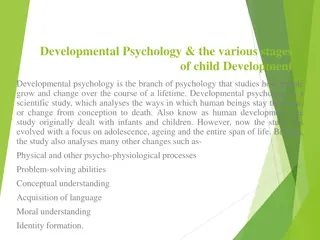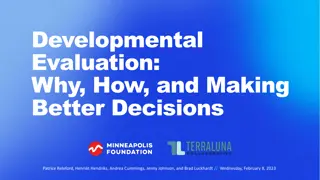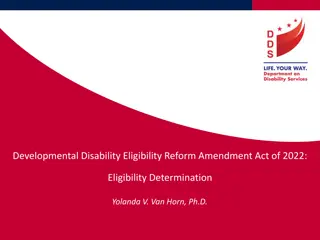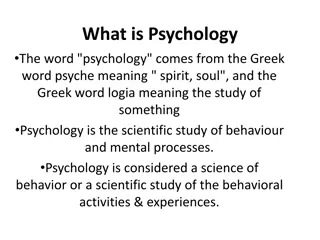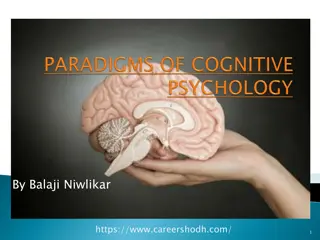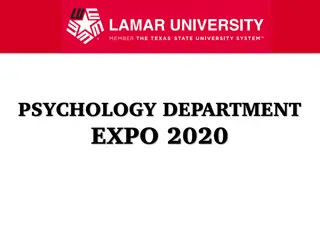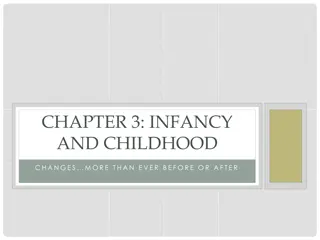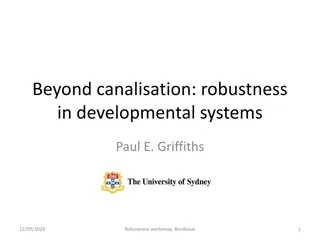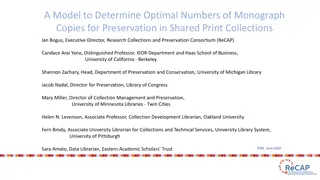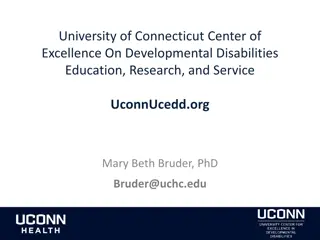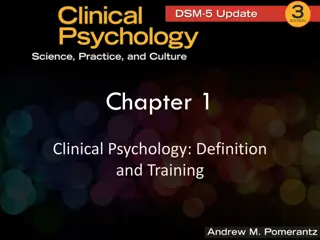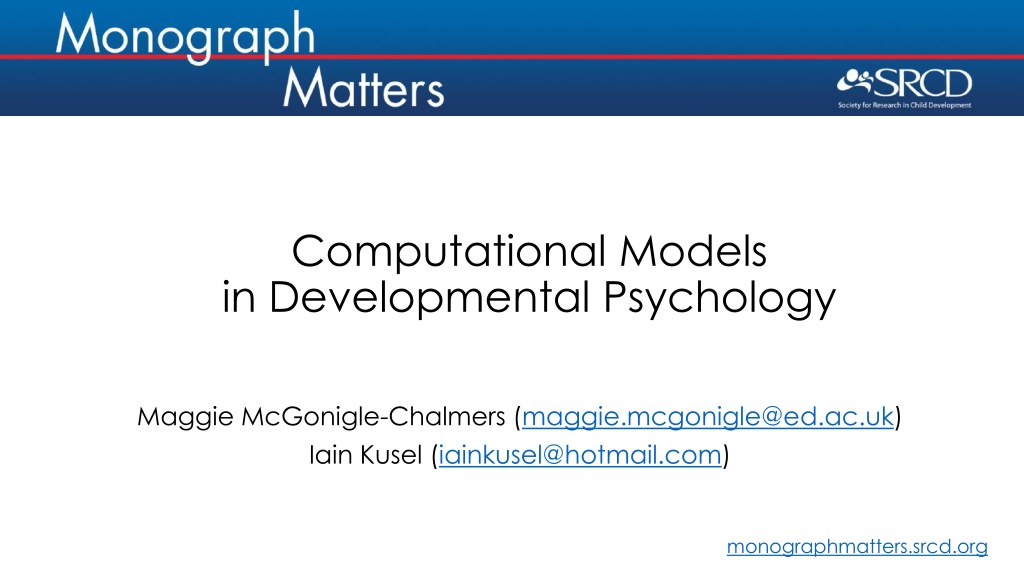
Emerging Models in Developmental Psychology Research
Explore the latest in computational modeling and developmental psychology research, including insights on mechanisms promoting change, developmental models taxonomy, production systems, connectionist models, dynamical systems, Bayesian models, and a hybrid model of emergent size sequencing. Discover exciting routes in modeling development.
Download Presentation

Please find below an Image/Link to download the presentation.
The content on the website is provided AS IS for your information and personal use only. It may not be sold, licensed, or shared on other websites without obtaining consent from the author. If you encounter any issues during the download, it is possible that the publisher has removed the file from their server.
You are allowed to download the files provided on this website for personal or commercial use, subject to the condition that they are used lawfully. All files are the property of their respective owners.
The content on the website is provided AS IS for your information and personal use only. It may not be sold, licensed, or shared on other websites without obtaining consent from the author.
E N D
Presentation Transcript
Computational Models in Developmental Psychology Maggie McGonigle-Chalmers (maggie.mcgonigle@ed.ac.uk) Iain Kusel (iainkusel@hotmail.com) monographmatters.srcd.org
Monograph citation McGonigle Chalmers, M. & Kusel, I. (2019). The development of size sequencing skills: an empirical and computational analysis. Monographs of the Society for Research in Child Development, 84(4). https://doi.org/10.1111/mono.12411 monographmatters.srcd.org
What should a model of development deliver? How best understand the transition mechanisms that promote change? First, simulate the competence of a child at an initial level X Second, establish a mechanism that can transform representations at X to a new level Y Finally, account for all activities between X and Y monographmatters.srcd.org
Developmental models taxonomy See Schlesinger & McMurray, 2012 monographmatters.srcd.org
Production systems model of seriation (Young, 1978) monographmatters.srcd.org
Connectionist model of seriation (Mareschal & Shultz, 1999) monographmatters.srcd.org
Dynamical systems of development ??+1 ??(1 + ? ?.?? ??) (1?) ??+1 ??(1 +?.(?? ??) ) (1?) ?? See van Geert (1994, p. 180; 2014, supplemental spreadsheet) monographmatters.srcd.org
Bayesian models of development See Lee & Sarnecka, 2011 monographmatters.srcd.org
A hybrid model of emergent size sequencing See McGonigle Chalmers & Kusel, 2019 monographmatters.srcd.org
Exciting routes towards modeling development Neuroconstructivism: encellment, embrainment, embodiment and ensocioment. (Sirois et al., 2008) Enaction and the cognitive dynamics of living systems (Di Paolo et al., 2017) Developmental and evolutionary robotics (Cangelosi et al., 2015; Pollack, 2014) Models of human logical reasoning (Stenning & Van Lambalgen, 2012) monographmatters.srcd.org
Where is my model in Poppers three worlds? Dynamical models World 1 World 3 World 2 Physical and biological Cultural artefacts Mental Symbolic models monographmatters.srcd.org
Concluding remarks Agent Many different types of ??+1 ?(??) model are needed to understand development! The importance of multiple representations (Minsky, 1988) monographmatters.srcd.org
Concluding remarks (con.) Piagetian criticisms of computational modeling: o Bayesian inference is only one learning rule of many. What s so special about it? (Bickhard, 2016) o implication is logically necessary, and so is not the same thing as stochastic likelihood . (Smith, 2011) Is it possible to model the emergence of necessary knowledge? monographmatters.srcd.org
References Bickhard, M. H. (2016). Probabilities over What? Human Development, 59(1), 34-36. Cangelosi, A., Schlesinger, M., & Smith, L. B. (2015). Developmental robotics: From babies to robots. MIT Press. Di Paolo, E., Buhrmann, T., & Barandiaran, X. (2017). Sensorimotor life: An enactive proposal. Oxford University Press. Lee, M. D., & Sarnecka, B. W. (2011). Number-knower levels in young children: Insights from Bayesian modeling. Cognition, 120(3), 391-402. Mareschal, D., & Shultz, T. R. (1999). Development of children s seriation: A connectionist approach. Connection Science, 11(2), 149 186. Mareschal, D. (2010). Computational perspectives on cognitive development. Wiley Interdisciplinary Reviews: Cognitive Science, 1(5), 696-708. monographmatters.srcd.org
References (con.) Minsky, M. (1988). Society of mind. Simon and Schuster. Pollack, J. B. (2014). Mindless intelligence: Reflections on the future of AI. In P. A. Vargas, E. A. Di Paolo, I. Harvey, I., & P. Husbands (Eds.), The horizons of evolutionary robotics. Cambridge: MIT Press. Schlesinger, M., & McMurray, B. (2012). The past, present, and future of computational models of cognitive development. Cognitive Development, 27(4), 326-348. Sch ner, G., & Spencer, J. (2015). Dynamic thinking: A primer on dynamic field theory. Oxford University Press. Simon, T. & Halford, G.S. (Eds) (1995) Developing Cognitive Competence: New Approaches to Process Modelling, Hillsdale, N.J.: Erlbaum monographmatters.srcd.org
References (con.) Sirois, S., Spratling, M., Thomas, M. S., Westermann, G., Mareschal, D., & Johnson, M. H. (2008). Pr cis of Neuroconstructivism: How the brain constructs cognition. Behavioral and Brain Sciences, 31(3), 321-331. Smith, L. (2011) in Goswami, U. C. The Wiley-Blackwell handbook of childhood cognitive development. Stenning, K., & Van Lambalgen, M. (2012). Human reasoning and cognitive science. MIT Press. van Geert, P. (1994), Dynamic systems of development: change between complexity and chaos, Harvester Wheatsheaf. van Geert, P. (2014). Dynamic modeling for development and education: from concepts to numbers. Mind, Brain, and Education, 8(2), 57-73. Young, R. M. (1978), Strategies and the structure of cognitive skill, Strategies of Information Processing, Underwood, G. (Ed.), Academic Press, London. monographmatters.srcd.org


